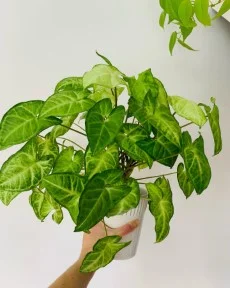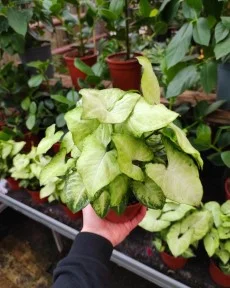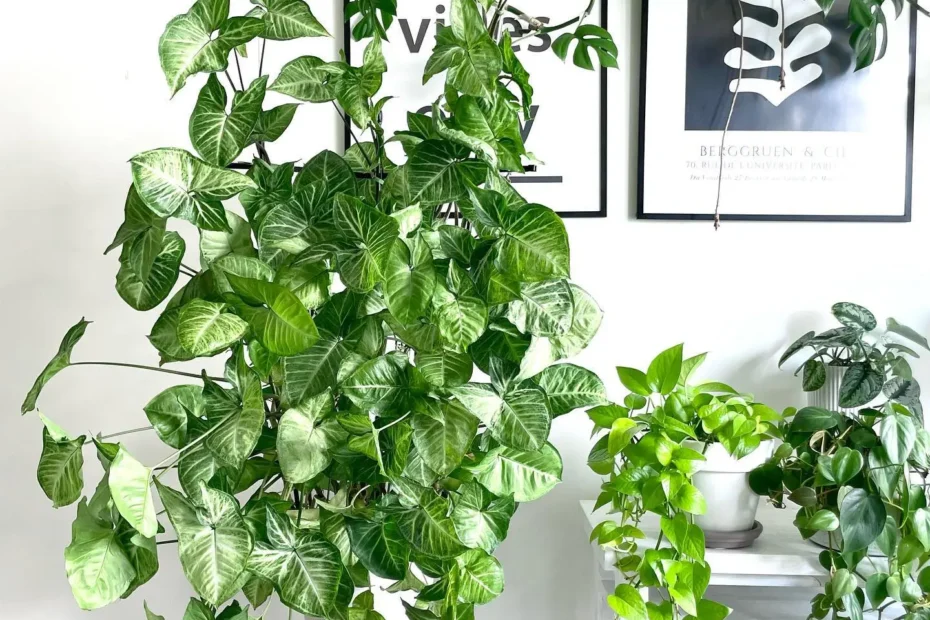Introduction
Imagine a plant so captivating, with leaves that mimic the elegant flutter of a butterfly’s wings. That’s the Syngonium White Butterfly for you, a specimen that combines nature’s beauty with an almost serene, easygoing disposition. I am a passionate houseplant enthusiast, having nurtured a diverse array of flora over the years. Yet, it’s the White Butterfly that holds a special place in my heart, with its unique charm and undemanding nature.
The Syngonium podophyllum ‘White Butterfly’ stands out not only for its aesthetic appeal but also for its provenance, hailing from the lush rainforests of Central and South America. This enchanting variety isn’t just a visual treat. It doubles as a natural air purifier, adding not only beauty but also health benefits to your home environment. Its resilient and forgiving nature makes it an excellent choice for both beginners and seasoned plant enthusiasts alike, underscoring its reputation as a versatile and cherished houseplant.
Unwrapping Syngonium White Butterfly Brilliance
Variegation Magic
The allure of the Syngonium White Butterfly‘s foliage lies in its mesmerizing variegation, a botanical spectacle where leaves exhibit multi-color patterns. This variegation results from the plant’s unique distribution of chlorophyll, the green pigment vital for photosynthesis. In variegated plants, some cells contain chlorophyll, while others do not, giving rise to the distinctive white and green pattern that resembles the wings of a butterfly.
Maintaining the vibrancy of these patterns requires specific care—bright, indirect light is paramount. Too little light, and the plant may revert to more green to maximize photosynthesis; too much, and the delicate white parts may scorch. Thus, positioning your Syngonium White Butterfly near a window with sheer curtains or in a brightly lit room without direct sunlight is ideal to preserve its enchanting variegation.
Growth Habits
Beyond its stunning foliage, the Syngonium White Butterfly offers dynamic growth habits, presenting a wonderful opportunity to add dimension to your indoor garden. Naturally, this plant is a climber, using aerial roots to ascend up trees in its rainforest home. In your space, it exhibits similar behavior, eagerly trailing or climbing when given the right conditions. To encourage vertical growth and mimic its natural habitat, providing support structures like moss poles or trellises proves beneficial.
Not only do these supports facilitate upward growth, but they also enhance leaf size and variegation. As the plant climbs, it undergoes a fascinating transformation, with its leaves changing shape and size, adding to its visual appeal. Regularly enjoy tying new growth gently to these supports, guiding your Syngonium White Butterfly as it reaches gracefully toward the light, creating a living piece of art in your home.
Syngonium White Butterfly’s Ideal Habitat
Light Requirements
Optimal lighting conditions are pivotal for the Syngonium White Butterfly, as they directly influence the vibrancy of its variegation and overall health. Bright, indirect light is the golden standard, essential for maintaining the distinct, crisp contrast between the white and green on the leaves. Direct sunlight, however, poses a significant threat — it can scorch the delicate leaves, leaving unsightly burns that mar its beauty.
Conversely, insufficient light can cause the plant to prioritize chlorophyll production for photosynthesis, leading to a loss of variegation as the leaves turn more green. A balance is thus crucial; find a spot that receives filtered sunlight most of the day, like near east-facing windows, to keep your Syngonium White Butterfly thriving.
Temperature and Humidity
Creating an environment that mimics the warm, humid conditions of its native rainforest habitat is key to seeing your Syngonium White Butterfly flourish. Ideal temperatures range between 60°F (15°C) and 80°F (27°C), which generally aligns with the comfort zone of most homes. However, this tropical plant also craves high humidity, thriving most in environments that simulate the moist, dense air of the jungle.
If your home’s air is too dry, consider employing humidity-enhancing techniques such as placing the plant on a pebble tray filled with water, using a humidifier, or grouping plants together to create a microclimate of moisture. These practices ensure your Syngonium White Butterfly remains not just alive, but luxuriant and vigorous, showcasing its exquisite beauty to the fullest.
Watering Wisdom for Syngonium White Butterfly
Understanding Watering Needs
Proper watering practices are critical to the health and beauty of your Syngonium White Butterfly. An essential caveat to bear in mind is the peril of overwatering, which can precipitate root rot, a condition that compromises the plant’s root system, leading to its potential demise.
Overwatering suffocates the roots, depriving them of oxygen and creating an environment where harmful fungi thrive. Thus, it’s paramount to strike a balance, ensuring the plant receives just the right amount of water to sustain its vibrant foliage without endangering its root health.
The Art of Watering
The methodology behind watering your Syngonium White Butterfly effectively hinges on moderation and keen observation. Begin by watering thoroughly, allowing water to flow freely out of the pot’s drainage holes, signifying that the soil has been adequately saturated. This technique ensures that every part of the root system has access to moisture, supporting healthy growth.
After watering, allow the top inch (approximately 2.5 cm) of soil to dry out before the next watering session. This approach helps mimic the natural watering patterns the plant would experience in its rainforest habitat, promoting optimal growth and preventing waterlogging.
Signs of Overwatering and Underwatering
Detecting and responding to the signs of overwatering and underwatering is crucial for the welfare of your Syngonium White Butterfly. Symptoms of underwatering include wilting and yellowing leaves, indicating the plant’s desperate need for hydration. In contrast, signs of overwatering manifest as mushy stems and browning leaves, suggesting that the plant is suffering from too much moisture.
To correct underwatering, steadily reintroduce water to the plant, allowing it to rehydrate gradually. If overwatering is the issue, reduce your watering frequency immediately and consider repotting the plant into fresh, dry soil to prevent further root damage. Adjusting your watering practices in response to these signs will help ensure your Syngonium White Butterfly remains a healthy, thriving component of your indoor garden.
Syngonium White Butterfly Nurturing Growth and Beauty


Fertilization: Enhancing Growth and Vibrancy
To ensure the Syngonium White Butterfly exhibits its most vigorous growth and maintains its stunning variegation, a regimented fertilization schedule is essential. During the spring and summer months—its active growing season—monthly fertilization with a diluted, balanced liquid fertilizer can significantly benefit the plant.
This practice replenishes essential nutrients in the soil, which may have been depleted through regular watering and plant uptake. The result is a more robust plant, with enhanced leaf coloration and variegation, ready to captivate any indoor garden enthusiast.
Cleaning and Pruning: Sustaining Health and Aesthetics
Maintaining clean, dust-free leaves is not merely about aesthetics; it’s a fundamental aspect of plant care that promotes optimal photosynthesis. Dust particles can block sunlight, reducing the Syngonium White Butterfly’s ability to produce the energy it needs for growth. Regularly wiping the leaves with a damp cloth not only keeps the plant looking its best but also supports its health and development.
Pruning plays a dual role in the care of your Syngonium White Butterfly. First, it encourages the plant to grow more densely, creating that desirable bushy appearance. Second, strategic pruning helps control the size and shape of the plant, ensuring it fits well within your space and aligns with your aesthetic preferences. Always use clean, sharp scissors or pruning shears to make precise cuts just above a leaf node, which can stimulate new growth and help maintain the plant’s vibrant and dynamic presence in your home.
Syngonium White Butterfly Propagation
Unveiling Propagation Secrets
The enchantment of a Syngonium White Butterfly can be shared and extended through the art of propagation, a process that not only duplicates its beauty but also enhances the botanical diversity of your living space. Stem cuttings, whether rooted in water or soil, present a straightforward yet effective method. To propagate through stem cuttings, select a healthy stem with at least two nodes and cut just below the node.
For water propagation, place the cutting in a glass jar filled with water, ensuring at least one node is submerged. Change the water weekly to encourage roots to flourish. For soil propagation, dip the cut end in rooting hormone and plant directly into moist potting mix, covering at least one node. Keep the soil consistently moist but not waterlogged to foster root development.
Division during repotting is another classical approach, particularly useful for mature plants that have outgrown their space. Carefully remove the plant from its pot and gently separate the roots to create two or more sections, each with its own set of stems and roots. Repot each new division into its container with a suitable potting mix, maintaining the same depth as before. This method not only propagates your plant but refreshes its environment, stimulating vigorous growth.
Advanced Propagation Techniques
For the adventurous plant parent, air layering offers a unique and rewarding propagation method for the Syngonium White Butterfly. This technique encourages roots to form on a part of the plant while it’s still attached to the parent, ensuring a well-developed root system before it’s even potted. Select a healthy stem and make a small upward slit below a node.
Insert a small piece of toothpick or matchstick to keep the slit open, encouraging the plant to form roots around the wound. Wrap moist sphagnum moss around the area and secure it with plastic wrap to create a humid microenvironment. Check the moisture level regularly, and within a few weeks to months, roots should appear within the moss.
Once a robust root system has developed, cut the new plant from the parent stem just below the new roots and pot it in a suitable potting mix. This method not only propagates your Syngonium White Butterfly but does so in a way that’s both intriguing and visually engaging, adding an extra layer of interest to your indoor gardening experience.
Troubleshooting Common Syngonium White Butterfly Woes
Pest and Disease Management
Pests like mealybugs and spider mites, along with diseases such as fungal gnats, pose significant threats to the health and vitality of your Syngonium White Butterfly. An organic and effective solution to combat these unwelcome guests is the use of neem oil or insecticidal soap. Neem oil, derived from the seeds of the neem tree, serves as a powerful, natural pesticide that disrupts the life cycle of pests without harming beneficial insects or the plant itself.
Applying a diluted neem oil solution to the affected areas of your plant can provide protection and relief from pest infestations. Insecticidal soap, another eco-friendly option, works by penetrating the outer layer of soft-bodied pests, effectively eliminating them. When treating with either solution, ensure thorough coverage, including the undersides of leaves where pests often reside.
Addressing Leaf Discoloration
Leaf discoloration, manifesting as brown, yellow, or pale leaves, signals underlying issues such as insufficient light, overwatering, or nutrient deficiency. Brown leaves often indicate overexposure to direct sunlight or under-watering. Relocating your plant to an area with indirect light and ensuring a consistent watering schedule can mitigate this issue. Yellow leaves can be a symptom of overwatering or poor drainage, which suffocates the plant’s roots.
Adjusting your watering practices and ensuring your pot has adequate drainage can reverse this concern. Pale leaves, on the other hand, may suggest a nutrient deficiency. Supplementing your feeding regimen with a balanced, diluted fertilizer can restore the lush, vibrant green hues of your Syngonium White Butterfly. By identifying and addressing the specific cause of leaf discoloration, you can rejuvenate your plant and maintain its aesthetic appeal.
Conclusion
In conclusion, caring for your Syngonium White Butterfly involves mindful pruning, propagation through stem cuttings, division, and air layering, alongside diligent pest and disease management and addressing leaf discoloration.
Success with your White Butterfly comes from observing and responding to its needs – a little attention goes a long way. My unique tip? Establish a consistent care routine but remain adaptable; your plant will communicate its needs through subtle cues.
I’d love to hear about your Syngonium White Butterfly journeys! Have tips, questions, or stories to share? Drop them in the comments section below. Your experience can shine a light for fellow plant enthusiasts!
